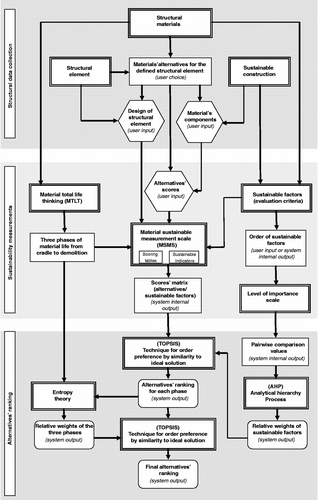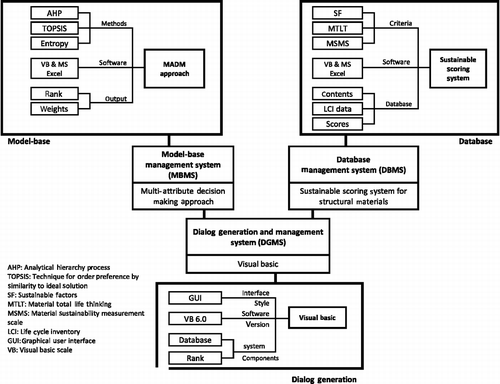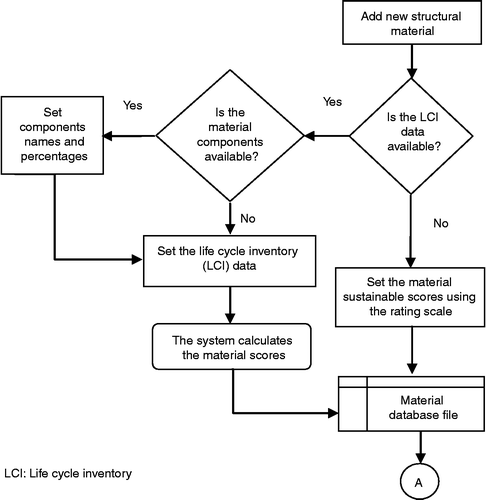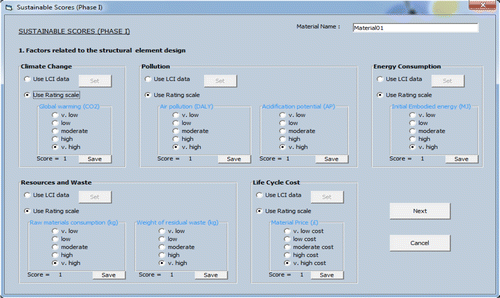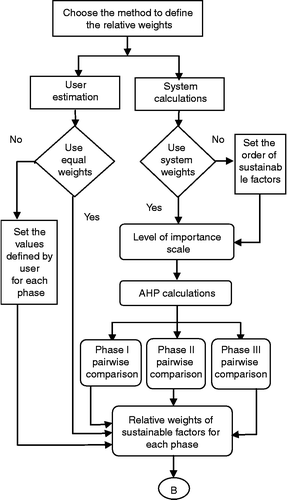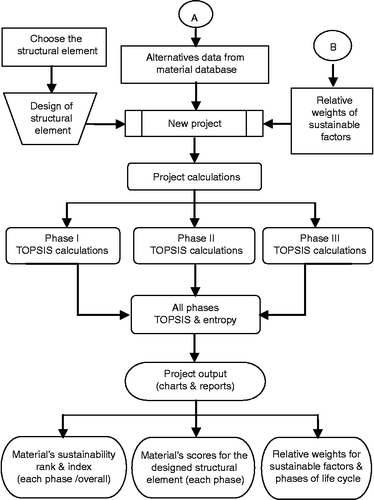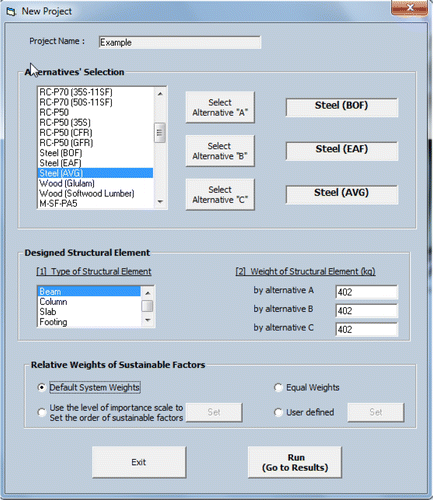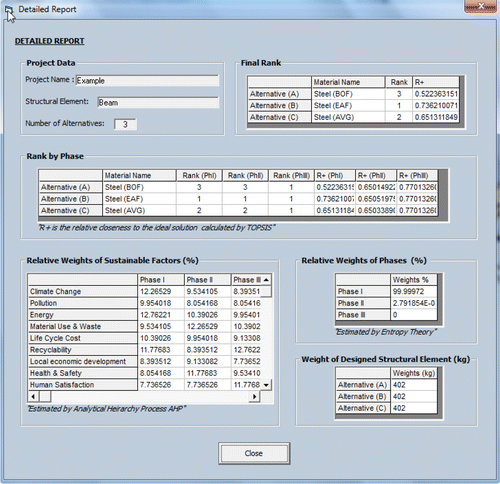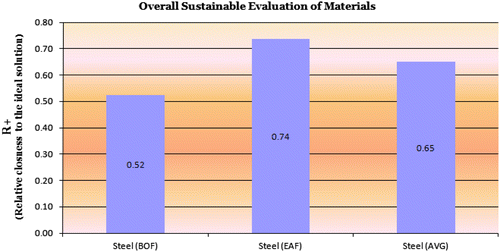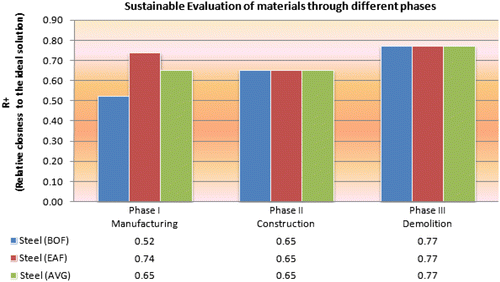Abstract
One of the sustainable construction keys is making decisions about the selection of structural materials on a sustainable whole life value basis. In order to make these decisions related to sustainable development, decision support system (DSS) can be used because it is a powerful tool especially if merged with multiple-criteria decision-making technique to expand its capabilities. This paper is concerned with developing a framework for a computer-based DSS that supports and facilitates the process of sustainable evaluation and selection of structural materials used in the construction industry. The system utilises the multiple criteria of sustainability and material total life thinking integrated into a multi-attribute decision-making approach to formulate the problem model. Microsoft Visual Basic and Excel are used to automate the system as well as to establish the graphical user interface. The paper presents the role that soft technology can play to move towards sustainable construction by developing an automated DSS to assist improving the quality of the decision-making process of sustainable selection of structural materials by linking it to the structural element design process.
1. Introduction
Nowadays, many countries are looking towards sustainable development as a goal, and consider the sustainability of construction projects as a key concern in order to achieve this goal (Rajagopalan Citation2007). Therefore, it is recommended by the department of trade and industry of UK to make decisions about construction projects based on sustainable whole-life value using a structured and robust decision-making process to make construction activities more sustainable (DTI Citation2006).
Technology should be considered during the sustainable development process due to its important role in the construction industry to proceed towards sustainability (Vanegas, DuBose, and Pearce Citation1995). Technology can play its role through three ways: hard technology such as equipment, soft technology such as systems, or knowledge and information such as databases (Plessis Citation2007). This paper presents the role that soft technology can play to move towards sustainable construction.
One of the keys to sustainable construction is the sustainable selection of materials because the correct material selection is an integral part of good design (Akadiri, Olomolaiye, and Chinyio Citation2013). Therefore, engineers need to turn their attention to design buildings using more sustainable materials. However, it is not a straight-forward decision because there is no measurement basis to compare materials and choose the more sustainable one (Obla Citation2009). Computing power offers attractive solutions for decision-makers such as computer-based systems that can assist to solve such complex problems. One of them is the decision support system (DSS) that is defined by Sauter (Citation1997) as, ‘a computer-based system that supports choice by assisting the decision maker in organising information and modelling outcomes’. The DSS technique is utilised to solve the research problem.
2. Problem definition and objectives
The decision-making process – regarding the evaluation and selection of the optimum sustainable structural materials in building structures – has many obstacles such as absence of standard selection module, lack of sustainability information, complexity of sustainability measurement, evaluation bias and mostly using one criterion for evaluation process that is the environmental impact. Therefore, there is a need for a more objective, systematic, comprehensive, automating and transparent system that utilises the multiple criteria of sustainability for this process in construction projects.
The main objective of this paper is to improve the quality of the above-mentioned decision-making process by presenting the development of a framework for a computer-based DSS that supports and facilitates the process of sustainable ranking and selection of structural materials. The system integrates sustainability criteria – including environmental, economic and social impacts during the material total life – into a decision-making process to encourage sustainable decisions in working practice.
3. Scope and limitation
The main process of that system is to rank the structural materials that can be used to design the structural elements of buildings. It links the output of design process by the input of the material selection process. It uses the following techniques: DSSs, multi-criteria decision-making (MCDM) and life cycle assessment. The system is developed to enable users to transform the amount of data into information that helps them to make good decisions. Both the structural design engineer and the project management team can use that system through the project initial design phase.
The framework of the developed DSS depends on the following two approaches by utilising them in the processes of sustainability measurements and ranking:
The developed sustainable scoring system (SSS) for structural materials evaluation by Bakhoum and Brown (Citation2012). It identified the sustainability criteria related to structural materials through the phases of material life using the total life thinking. In addition, life-cycle assessment method was employed to evaluate the sustainability of materials during their whole life-cycle.
The developed MCDM approach by Bakhoum and Brown (Citation2013). It is a hybrid approach using analytical hierarchy process (AHP), technique for order preference by similarity to ideal solution (TOPSIS) and entropy methods for sustainable ranking of structural materials.
4. Methodology
The methodology used to structure the framework and logic of the computer-based DSS can be summarised in the following steps:
Draw the logic of the sustainable decision support system (SDSS) that explains the system flow of information including its different sources, steps and channels from start to end of the decision process.
Structure the architecture of the SDSS using the DSS technique because it is suitable for analysing and supporting decisions in such problems due to its interactivity, simplicity and flexibility, and can be successfully adapted to reach decisions about sustainable development. It enhances the traditional information access, storage and retrieval functions with support for model building and model-based reasoning (Eom Citation2001).
Structure the computer logic of the automated program. After that, using Visual Basic (VB) programing language and Microsoft Excel Software to apply it and establish the automated (computer-based) SDSS.
System testing and verification using case studies, results analysis and comparing results with the findings of other research studies.
5. Literature review
Sustainable development is quickly becoming a global phenomenon that has been focused on by many researchers (Yang, Brandon, and Sidwell Citation2005; Cabeza et al. Citation2014). The most widely used definition of sustainable development is ‘Development that meets the needs of the present without compromising the ability of future generations to meet their own needs’ (WCED Citation1987). The construction industry has a vital contribution to make to sustainable development (Harrison Citation2006; Zang et al. Citation2014). One of the contribution areas is the sustainable selection of materials (Akadiri, Olomolaiye, and Chinyio Citation2013).
Most developed strategies for materials selection in the construction industry are based on the combination of physical and mechanical properties. Multi-criteria decision analysis methods are used in the process of material selection such as the approaches carried out by Shanian and Savadogo (Citation2006), Jee and Kang (Citation2000), Akadiri, Olomolaiye, and Chinyio (Citation2013) and Jahan et al. (Citation2010). However, there are some methodologies that are concerned with the environmental impact as a criterion for materials selection such as studies done by Rameezdeen and Manewa (Citation2006), Gonzalez and Navarro (Citation2006), Struble and Godfrey (Citation2004) and and Sturges (Citation1999). Sometimes, economical and environmental factors may be combined to assess the structural design (Hong, Ji, and Park Citation2012). However, it is difficult to determine where and when they should be used and who should use them. Moreover there is no link between the selection of materials and the structural design.
Eco-Design is also known as design for environment. The strategies for Eco-Design include using materials with low environmental impact, choosing clean production processes, avoiding hazardous and toxic materials, maximising the efficiency of the energy used for production and for the product in use, and designing for waste management and recycling (Ljungberg Citation2007). Wang, Chang, and Nunn (Citation2010) adopted a methodology that integrated life-cycle assessment process including life-cycle costing, MCDM and group decision-making methods in order to select sustainable design options for building projects.
There are many building environmental assessment tools that can be used to provide the environmental impacts of buildings (Trusty and Horst Citation2002). However, these tools depend on a single criterion which is the environmental impact. In addition, they have been developed for different objectives depending on different databases, regulations and guidelines. Therefore, there are variations between them in goals, factors and the weights of these factors which can make confusion for users to choose the suitable tool.
A multi-criteria decision analysis is an effective way to carry out a well-designed decision process and support sustainable development due to the complex nature of sustainability problems (Omann Citation2004). Sustainability criterion has multiple attributes such as environment, economic and social factors. Multi-attribute decision-making (MADM) that has a methodology aiming at improving decision quality is defined by Yoon and Hwang (Citation1995) as ‘Making preference decisions over the available alternatives that are characterised by multiple, usually conflicting, attributes’. In the 1980s, DSSs were merged with MCDM methods in order to expand its capabilities to create a multi criteria decision support system (MCDSS). A number of MCDSSs have been found in different research domains (Jin Citation2005).
DSSs have been created in different areas in the construction field. For example, DSS for material selection such as those developed by Pearce, Hastak, and Vanegas (Citation1995) and Zavadskas et al (Citation2005); DSS for the contractor selection such as that developed by Moustafa (Citation2001); and DSS for optimal ranking of buildings on economic and environmental basis by Ibn-Mohammed et al. (Citation2014). Most of these systems have similar general principles of architecture and operation. However, the used methods and techniques in these systems are different based on their aims and available data. Most of these systems are limited to specific databases.
6. The logic of the developed SDSS
The logic of designing the SDSS depends on the description of DSS by Eom (Citation2001) as a computer-based interactive human–computer decision-making system that supports decision-makers rather than replacing them. Figure presents the full flowchart that introduces the relationship between the different items in the SDSS. The logic can be presented as three related stages.
6.1 Structural data collection
The information gathering task was identified by Paul (Citation1993) as a major contributor to the decision-making process. Therefore, this stage presents the main sources of information gathering that is required to provide the system with data and information. All these data are related to the construction industry including the structural materials, structural design and the sustainable construction development. The system material alternatives, evaluation criteria and weights of the structural elements can be determined from these sources.
6.2 Sustainability measurements
This stage replies to one question that is ‘How to measure the sustainability of structural materials?’ Therefore, the SSS established by Bakhoum and Brown (Citation2012) is used to measure the sustainability of structural materials through their life-cycle by estimating the material sustainable scores. After that, these scores can be stored in the SDSS's database.
6.3 Ranking of alternatives
This stage replies to one question that is ‘How to rank structural materials based on multiple attributes of sustainability through their total life for a designed structural element?’ Therefore, the MADM approach developed by Bakhoum and Brown (Citation2013) is used in this stage. It can be considered as the system model because this stage includes all calculations of the methods used such as AHP, TOPSIS and entropy method.
7. Architecture of the developed SDSS
Figure presents the fundamental three components of the developed SDSS. Building the system database management system (DBMS) and model-base management system (MBMS) depends on the approaches developed by Bakhoum and Brown (Citation2013) – as mentioned previously – assisted by Microsoft Excel Software.
7.1 Database management system
DBMS can be considered as a data store for the DSS. It is used as a separation between the users and physical framework of the database (Druzdzel and Flynn Citation2002). The DBMS stores large quantities of data including materials components, life-cycle inventory (LCI) data, and the sustainable scores of materials using the SSS. The DBMS is embedded within a DSS generator to allow users to create and manage the database file that is used as an input data to the SDSS.
7.2 Model-based management system
The main function of the MBMS is to separate DSS's model from its applications. The system model uses the developed hybrid MADM approach (AHP, TOPSIS and entropy methods) to allow the MBMS to compile the DBMS's data into information to make decisions for the evaluation, ranking and selection of structural materials on a sustainability basis. The MBMS is embedded within the SDSS generator to allow users to create, edit and delete a model.
7.3 Dialogue generation and management system
The dialogue generation and management system (DGMS) forms the user interface with the DSS. The VB programing language was implemented to develop the DGMS and to allow the DGMS to communicate with the DBMS and MBMS. The user and the user interface are screened from the physical details of the model base and database implementation by the DGMS. The user interface subsystem is the only part of DSS components with which users have to interact. Therefore, the SDSS is equipped with an effective and easy-to-use user interface that manages several important issues including form design, data and information presentation format, menu simplicity and choice of output formats. VB was utilised to develop the graphical user interface of the SDSS to be the gateway to both DBMSs and MBMSs.
8. Computer logic of the automated program by VB
VB is a computer language that has been developed to help creating programs that will work within the windows operating system. It provides powerful features such as graphical user interfaces, event handling, object-oriented features and structured programing (H. Deitel, P. Deitel, and Nieto Citation1999; McKeown Citation1999). VB language has a wide range spread of use because it can be adapted to many Microsoft and even non-Microsoft application software packages and it is relatively easy (Albright Citation2007).
The computer logic of the automated program divides the program into two main parts, Database and Model (Figure ). Database is concerned by add, save, display and delete the data for each material. Data file includes material name, components name, their percentages and sustainable scores. The model is concerned with ranking the selected alternatives of materials based on sustainable scores (from database) and the relative weights of sustainable factors.
8.1 Material database
Figure presents the flowchart for the logic of adding a new material to the system material database. The system starts by asking the user to enter the name of the new structural material, then asking about the availability of LCI data. In cases where the LCI data are not available, the user has to depend on the material sustainable measurement scale to set the scores of sustainable factors for the material by choosing very high, high, moderate, low and very low choice regardless of any values (Figure ). On the other hand, if the LCI data are available, the user has to set these values to calculate the sustainable indicators for sustainable factors. Then, the scores of sustainable factors for the material will be calculated automatically by the system. Before setting the LCI data, the user has to set the components names, their percentages and their LCI data.
8.2 Relative weights of sustainable factors
Figure presents the flowchart for the logic of determining the relative weights of sustainable factors. It depends on two directions: system calculation and user estimation.
The system calculation means applying the pairwise comparison method (automatically by the system) to determine the factors’ relative weights. It is applied even using the default system weights (without any input from the user) or setting the order of sustainable factors by the user using the level of importance scale. User estimation means that the relative weights of sustainable factors are entered directly by the user without applying the pairwise comparison method. It can be done even using equal weights or user-defined weights.
8.3 Decision model
Figure presents the flowchart for the logic of adding a new project (model) to rank different alternatives. This is the main process of the DSS. In this process the user has to choose the alternatives (structural materials) from the database, and to define the structural element and its weight (see Figure ). The weight of the structural element should be calculated, from design, for each alternative. After that, the system calculations are processed using TOPSIS and entropy using Microsoft Excel for each phase of a material's life. The user can get the output of these calculations in both report forms and graphs. The outputs are alternative ranks, either for each phase separately or final rank, and relative weights for sustainable factors and phases of material life.
9. System advantages comparing with other tools and methods
9.1 Flexibility
The system has been developed to be as flexible as possible so that it can be applied on any structural materials (conventional, improved or new) in buildings. This advantage is due to the flexibility of the system materials database unlike most existing material selection systems that have a fixed database for definite materials. The system depends on user input data of materials that can be modified by the user at any time
9.2 Address the multiple-criteria of sustainability
The system has been developed based on the multiple sustainability criteria including environmental, economic, social and technological aspects. Therefore, it makes a shift from green building (only environmental impact) to sustainable building which gives the system an advantage more than other existing environmental assessment tools.
9.3 Integrate design and material selection in a decision-making process
The system considers the structural element design in the sustainable evaluation process of the structural material. It links between the two processes by using the output of design process as an input in the material selection process. Most evaluation systems based on sustainability consider the overall building or building spaces and floors. Most material selection systems select the material based on its properties and regardless of the structural element design.
9.4 Apply total life thinking
The system has been developed to consider the total life thinking by evaluating the structural materials over the different phases of material life to support decisions without bias. In addition, it gives material rank and sustainability degree both for each phase and for total material life.
9.5 User friendly
The system is user friendly that works under Microsoft Windows operating system. It simplifies the process of sustainable comparison between materials, and provides indicative reports and charts for the results in both brief and detailed forms.
10. System testing and verification
System testing and verification process was performed by conducting 42 applications and case studies to check that the system fulfils its intended purpose for selecting the optimum sustainable structural material. Both five-point rating scale and actual LCI values were used to set the sustainability scores of materials. On the other hand, sensitivity analysis of system output results is applied to analyse the results and demonstrate how the input parameters affect the output results.
10.1 System testing
The system was tested to assess its reliability and consistency for identifying sustainability evaluation of materials. Virtual materials having extreme sustainable score values were utilised in this step to test the system and evaluate its output results. The five-point rating scale was used to define the sustainable scores for alternatives. It included 22 applications that were performed in order to analyse and assess the system results based on different parameters of the system boundaries. In each application, all parameters were fixed except one to study its effect on the sustainability evaluation. In addition, the extreme values of sustainable scores were used for the chosen alternatives to identify the extreme system results and the maximum differences between the results’ values.
10.2 System verification
Real structural materials were utilised in this step to verify the system and evaluate its output results. The actual figures of LCI data were collected and used to define the sustainable scores for alternatives. System verification included 20 actual cases of study which were conducted for different combinations of case studies to determine system consistency and reliability.
Twenty-three different types of structural materials used in the construction projects were selected as alternatives in the case studies for implementation by the system. Fifteen reinforced concrete types having different performance criteria were considered: 20, 25, 35 and 50 MPa ready-mix concrete as well as 50 and 70 MPa precast concrete. In addition, combinations of cement for each concrete performance criteria were considered: 100% Portland cement, 11%, 20%, 35% and 50% substitution of by-products (slag cement – fly ash – silica fume) for the Portland cement. Moreover, different types of reinforcement were considered: steel bars, carbon fibres and glass fibres. Three types of metals (steel grade S355) were considered: steel [virgin base manufacturing, basic oxygen furnace (BOF)], steel [recycled base manufacturing, electric arc furnace (EAF)] and steel [average (AVG) manufacturing] with recycled contents 18%, 90% and 49%, respectively. Two types of wood were considered: softwood timber and glue-laminated timber. Three types of bricks were considered: clay, sand–lime and concrete bricks.
The structural elements considered in the study cases were designed – according to codes of British standards – for the different types of selected structural materials.
The raw LCI data were collected for the structural materials’ components from different resources based on reports, papers, fact sheets, technical manuals and databases of the following institutes, universities and organisations: Portland Cement Association, American Concrete Institute, Athena Institute, National Ready Mix Concrete Association, SPINE LCI database, Concrete Centre, Consortium for Research on Renewable Industrial Materials, Bath University, Australian Steel Institute, Swedish Institute of Steel Construction, National Institute of Standards and Technology, ELSEVIER and Japan Society of Civil Engineers (Marceau, Nisbet, and VanGeem Citation2007; Prusinski, Marceau, and VanGeem Citation2004; Penttala Citation1997; Athena Citation2005; Venta Citation1998; NRMCA Citation2008; SPINE Database Citation2013; Porritt Citation2009; Puettmann and Wilson Citation2005; Wagner, Puettmann, and Johnson Citation2009; Hammond and Jones Citation2008; Strezov and Herbertson Citation2006; Widman Citation2005; Lippiatt Citation2007; Joshi et al. Citation2004; Shimomura, Nishizak, and Tanaka Citation2009).
10.3 System application (case study)
One case study can be presented as a simple worked example that explains the system output and its validity. In this case, three alternatives of structural steel depending on the manufacturing method were selected to present their effect on sustainability. The first method is BOF, the second is EAF and the third is an AVG between both of them (AVG). Each method uses different amounts of energy (about 31,300, 12,100, 21,700 MJ/ton, respectively), percentage of recycled steel contents (18%, 90% and 49%, respectively) and emitted different amounts of emissions (about 2600, 1017 and 1809 kg CO2 per ton, respectively). The structural element considered is a simple beam with the same design and weight because the three alternatives were of the same material. Input user interface is presented in Figure .
The output system report – as presented in Figure – indicates that the steel manufactured by the EAF method is more sustainable than that manufactured by the BOF method. The steel manufactured by the AVG method has a position between them (sustainability rank is 74, 52 and 65, respectively). This is due to the differences in recycled contents as well as emissions and embodied energy in Phase I as presented in Figures and ). Phases II and III have no effect because the alternatives are of the same material; therefore, sustainability ranks are similar (65 for phase II and 77 for phase III).
10.4 Comparing studies
It is valuable to compare the system results with the results of other research. However, it is very difficult to make a reliable comparison between different researches because each study has different boundaries, databases and includes different levels of detail. However, four studies had already been done to compare the system results with the findings of three research studies as well as BRE Green Guide to Specification [BRE (Building Research Establishment). ’Green Guide to Specification’. http://www.bre.co.uk/greenguide/podpage.jsp?id = 2126]. The three research studies were done by Guggemos and Horvath (Citation2005), Struble and Godfrey (Citation2004), and Petersen and Solberg (Citation2002).
10.5 Analysis and discussion
Based on the sensitivity analysis, it is concluded that the system is reliable as it provided a significant sustainable rank of structural material based on the defined criteria. In addition, the repeated measurements under the same circumstances tended to produce the same results. On the other hand, the relative closeness to the ideal solution R+ provided a very good indication of the degree of materials’ sustainability. Globally, the system has validity that it represents the theoretical construct it is meant to measure. However, the quality of data is very important to assure the correctness of the results. Consequently, it is important to understand that the system results depend on quality of the input data. It means that the more precise the input entered to the system, the more reliable and indicative the output results.
When comparing the system output results with the findings of other research, it can be seen that the results are similar even for the factors of environmental impact (consumed energy, environmental emissions, resource and waste), cost or for all sustainable factors. Overall, it can be seen that for a single sustainable factor it may be found that a structural material is better than another material; however, for more than one factor (i.e. multiple attribute criteria) the other material is globally better.
Overall, it can be seen that for a single sustainable factor it may be found that a structural material; however, for more than one factor (i.e. multiple attribute criteria) the other material is globally better. It supports the methodology for adopting the MADM methods to evaluate and select the sustainable material. Finally, the system is user friendly and provides indicative reports and charts for the results in both brief and detailed view.
11. Conclusion and recommendations
The construction industry has a vital contribution to make sustainable development. It has a major role that can play to support the environmental, economic, social and technological growth in society (ICE Citation2002; Addis and Talbot Citation2001). Therefore, this research developed a framework for an automated computer-based SDSS that presents the role of soft technology to move towards sustainable construction. It can potentially assist decision-makers to select materials based on sustainable whole-life value that leads to achieve more sustainable construction development by building more sustainable buildings.
The research merged DSS with MCDM methods in order to expand its capabilities to create a MCDSS. It developed an objective, systematic, comprehensive and automated method that utilises multiple criteria of sustainability (environment, economic and social factors) to support decisions related to the evaluation and selection of structural materials, which is not limited by a single decision criterion.
The developed SDSS integrates sustainability into a decision-making process to encourage sustainable decisions in working practice. The material selection process should not be based only on mechanical or physical properties. In addition, it has the following advantages: flexibility, address the multiple-criteria of sustainability, integrate design and material selection in a decision-making process, apply total life thinking and user friendliness.
According to the system testing and verification results and analysis, it is concluded that the system uses reliable techniques and prudent practices, and performs the selected functions in a correct manner.
Sustainability points the way to the future; therefore, it is expected from researchers to make more efforts to achieve more sustainable construction development in the future in different areas such as the following.
There are a few available LCI databases. Moreover, access to their information is generally restricted or protected by copyright agreements or the data are not verifiable. Availability of the LCI data would provide the decision-maker the required information for the decision-making process such as the proposed SDSS. Therefore, it is intended to establish more LCI databases to serve the needs of the potential data users which can contribute to improving the decision-making process.
Structural design and sustainable structural material selection can be integrated into one decision-making system (integrated design) that uses both sustainable and technical aspects in parallel to save time/effort and maximise the building's sustainability aspects throughout its life.
Future development of web-based model for such SDSS can be established.
References
- AddisB., and R.Talbot. 2001. Sustainable Construction Procurement: A Guide to Delivering Environmentally Responsible Projects. London: Construction Industry Research and Information Association (CIRIA).
- AkadiriP. O., P. O.Olomolaiye, and E. A.Chinyio. 2013. “Multi-Criteria Evaluation Model for the Selection of Sustainable Materials for Building Projects.” Automation in Construction30: 113–125.
- AlbrightS. C.2007. VBA for Modulers: Developing Decision Support Systems with Microsoft Excel. 2nd ed. Duxbury, MA: Thomson Brooks.
- Athena. 2005. Cement and Structural Concrete Products: Life Cycle Inventory Update 2. Ottawa: Athena Sustainable Materials Institute.
- BakhoumE., and D.Brown. 2012. “A Developed Sustainable Scoring System for Structural Materials Evaluation.” Journal of Construction Engineering and Management ASCE130: 110–119.
- BakhoumE., and D.Brown. 2013. “A Hybrid Approach Using AHP–TOPSIS–Entropy Methods for Sustainable Ranking of Structural Materials.” International Journal of Sustainable Engineering6 (3): 212–224.
- CabezaL. F., L.Rincón, V.Vilariño, G.Pérez, and A.Castell. 2014. “Life Cycle Assessment (LCA) and Lifecycle Energy Analysis (LCEA) of Buildings and the Building Sector: A Review.” Renewable and Sustainable Energy Reviews29: 394–416.
- DeitelH. M., P. J.Deitel, and T. R.Nieto. 1999. Visual Basic 6 How to Program. Uppersaddle River NJ: Prentice-Hall.
- DruzdzelM. J., and R. R.Flynn. 2002. Decision Support Systems. 2nd ed. New York: Marcel Dekker.
- DTI (Department of Trade and Industry). 2006. Sustainable Construction Strategy. Department of Trade and Industry. www.dti.gov.uk.
- EomS. B.2001. Decision Support Systems. 2nd edLondon: International Thomson Business Publishing.
- GonzalezM. J., and J. G.Navarro. 2006. “Assessment of the Decrease of CO2 Emissions in the Construction Field Through the Selection of Materials: Practical Case Study of Three Houses of Low Environmental Impact.” Building and Environment41: 902–909.
- GuggemosA. A., and A.Horvath. 2005. “Comparison of Environmental Effects of Steel and Concrete Framed Buildings.” Journal of Infrastructure Systems (ASCE)11(2): 93–101.
- HammondG., and C.Jones. 2008. Inventory of Carbon and Energy (ICE) Version 1.6a. Bath: University of Bath.
- HarrisonJ.2006. “The Role of Materials in Sustainable Construction.” In Materials Forum, edited by R. Wuhrer and M. Cortie, 110–117. Volume 30. Institute of Materials Engineering Australasia.
- HongT., C.Ji, and H.Park. 2012. “Integrated Model for Assessing the Cost and CO2 Emission (IMACC) for Sustainable Structural Design in Ready-Mix Concrete.” Journal of Environmental Management103: 1–8.
- Ibn-MohammedT., R.Greenough, S.Taylor, L.Ozawa-Meida, and A.Acquaye. 2014. “Integrating Economic Considerations with Operational and Embodied Emissions into a Decision Support System for the Optimal Ranking of Building Retrofit Options.” Building and Environment72: 82–101.
- ICE (Institution of Civil Engineers). 2002. Society, Sustainability and Civil Engineering. London: Institution of Civil Engineers.
- JahanA., M. Y.Ismail, F.Mustapha, and S. M.Sapuan. 2010. “Material Selection Based on Ordinal Data.” Material Design31 (7): 3180–3187.
- JeeD. H., and K. J.Kang. 2000. “A Method for Optimal Material Selection Aided with Decision Making Theory.” Materials and Design21: 199–206.
- JinL.2005. “A Fuzzy Multi-Criteria Decision Analysis for Assessing Technologies of Air Pollution Abatement at Coal-Fired Power Plants.” Master of Engineering: Environment Systems Engineering, University of Regina.
- JoshiS. V., L. T.Drzal, A. K.Mohanty, and S.Arora. 2004. “Are Natural Fiber Composites Environmentally Superior to Glass Fiber-Reinforced Composites?” ELSEVIER, Composites: Part A35: 371–376.
- LippiattB. C.2007. Building for Environmental and Economic Sustainability (BEES 4): Technical Manual and User Guide. Gaitherburg, MD: National Institute of Standards and Technology, Department of Commerce.
- LjungbergL. Y.2007. “Materials Selection and Design for Development of Sustainable Products.” Materials and Design28: 466–479.
- MarceauM. L., M. A.Nisbet, and M. G.VanGeem. 2007. Life Cycle Inventory of Portland Cement Concrete, 121. Skoki, Il: Portland Cement Association (PCA).
- MckeownPatrick G.1999. Learning to Program with Visual Basic. New York: Wiley.
- MoustafaI. M.2001. “A Decision Support System for the Selection of the Optimum Contractor.” PhD diss., University of Southampton.
- NRMCA (National Ready Mixed Concrete Association). 2008. Concrete CO2 Fact Sheet. http://www.nrmca.org/greenconcrete/.
- OblaK. H.2009. “What is Green Concrete?” The Indian Concrete Journal24: 26–28.
- OmannI.2004. “Multi-Criteria Decision Aid As an approach for Sustainable Development Analysis and Implementation.” Doctoral diss., University of Graz.
- PaulC. R.1993. Decision Support Systems: Theory and Practice. Orchards: Alfred Waller.
- PearceA. R., M.Hastak, and J. A.Vanegas. 1995. “A Decision Support System for Construction Materials Selection Using Sustainability As a Criterion.” In Proceedings of the NCSBCS Conference on Building Codes and Standards, 1–4. Albuquerque, NM.
- PenttalaV.1997. “Concrete and Sustainable Development.” ACI Materials Journal94: 409–416.
- PetersenA. K., and B.Solberg. 2002. “Greenhouse Gas Emissions, Life-Cycle Inventory and Cost-Efficiency of Using Laminated Wood Instead of Steel Construction, Case: Beams at Gardermoen Airport.” Environmental Science & Policy, ELSEVIER5: 169–182.
- PlessisC.2007. “A Strategic Framework for Sustainable Construction in Developing Countries.” Construction Management and Economics25: 67–76.
- PorrittJ.2009. The Concrete Industry Sustainability Performance Report. First Report. The Concrete Centre.
- PrusinskiJ. R., M. L.Marceau, and M. G.VanGeem. 2004. “Life Cycle Inventory of Slag Cement Concrete.” In Proceedings of the Eighth CANMET/ACI International Conference on Fly Ash, Silica Fume, Slag and Natural Pozzolans in Concrete, 65–92.
- PuettmannM. E., and J. B.Wilson. 2005. “Gate-to-Gate Life-Cycle Inventory of Glued-Laminated Timbers Production.” Wood and Fiber Science, CORRIM Special Issue37: 99–113.
- RajagopalanN.2007. “Environmental Life-Cycle Assessment of Highway Construction Projects.” Master of Science, Texas A&M University.
- RameezdeenR., and R. M.Manewa. 2006. “An Integration of Value Management and Enironement Sustainability to Select Construction Materials.” The Value Manager (The Official Publication of the Hong Kong Institute of Value Management)12 (1): 8–12.
- SauterV. L.1997. Decision Support System: An Applied Managerial Approach. New York: John Wliey & Sons.
- ShanianA., and O.Savadogo. 2006. “A Material Selection Model Based on the Concept of Multiple Attribute Decision Making.” Materials and Design27: 329–337.
- ShimomuraT., I.Nishizak, and H.Tanaka. 2009. Report on JSCE Committee Activities on LCA and LCC of FRP Infrastructure. Sapporo: JSCE.
- SPINE Database. 2013. (CPM LCA Database). Accessed July. http://www.lifecyclecenter.se/tools-data/cpm-lca-database/.
- StrezovL., and J.Herbertson. 2006. A Life Cycle Prospective on Steel Building Materials. Toronto, Australia: The Crucible group Pty.
- StrubleL., and J.Godfrey. 2004. “How Sustainable is Concrete?” International Workshop on Sustainable Development and Concrete Technology, Beijing, China, May 20–21, 201–211.
- SturgesJ. L.1999. “Construction Materials Selection and Sustainability.” In 2nd International Conference on Construction Industry Development, vol. 1, 297–304. Singapore.
- TrustyW. B., and S. W.Horst. 2002. “Integrating LCA Tools in Green Building Rating Systems.” In The Austin Papers: Best of the 2002 International Green Building Conference, 53–57. Brattleboro, VT: Building Green.
- VanegasJ. A., J. R.DuBose, and A. R.Pearce. 1995. “Sustainable Technologies for the Building Construction Industry.” In Proceedings of the Symposium on Design for the Global Environment. Atlanta, GA: Georgia Institute of Technology, Health Environments Research Group HERG Publications.
- VentaG. J.1998. Life Cycle Analysis of Bricks and Mortar Products. Ottawa: Athena Sustainable Materials Institute.
- WagnerF. G., M. E.Puettmann, and L. R.Johnson. 2009. Life Cycle Inventory of Inland Northwest Softwood Lumber Manufacturing. CORRIM Publications. http://www.corrim.org/pubs/reports/2010/phase2/Module_B.pdf.
- WangN., Y.Chang, and C.Nunn. 2010. “Lifecycle Assessment for Sustainable Design Options of a Commercial Building in Shanghai.” Building and Environment45: 1415–1421.
- WCED (World Commission on Environment and Development). 1987. Our Common Future. Oxford: Oxford University Press.
- WidmanJ.2005. Sustainability of Steel-Framed Multi-Storey Buildings for Commercial and Residential Use. Swedish Institute of Steel Construction. http://www.sbi.nu/uploaded/dokument/files/SBI-Sustainability_of_steel_framed_buildings.pdf.
- YangJ., P. S.Brandon, and A. C.Sidwell. 2005. Smart & Sustainable Built Environments. Oxford: Blackwell.
- YoonK. P., and C. L.Hwang. 1995. Multiple Attribute Decision Making: An Introduction. Thousand Oaks, CA: Sage.
- ZangX., Y.Wu, L.Shen, and M.Skitmore. 2014. “A Prototype System Dynamic Model for Assessing the Sustainability of Construction Projects.” International Journal of Project Management32: 66–76.
- ZavadskasE. K., A.Kaklauskas, A.Banaitis, and V.Trinkunas. 2005. “System for Real Time Support in Construction Materials Selection.” International Journal of Strategic Property Management9: 99–109.

